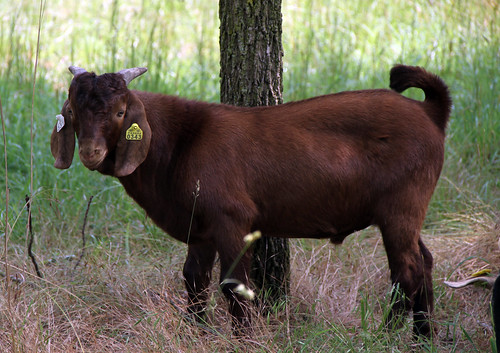An individual fecal sample (2-4 g) was collected from each buck's rectum on May 31. The samples were collected on ice and transported in a cooler to Delaware State University where fecal egg counts will be determined using the modified McMaster procedure.
A pooled sample was also collected. It was formed from random fecal samples from each consignment. It was also transported to Delaware State University for larvae culture. The larvae culture takes several weeks to complete. It will indicate which strongyle(round)-type worms were infecting the goats on May 31.
On May 31, fecal egg counts ranged from 0 to 3,150 epg and averaged 324 + 584 epg (of feces). The median egg count was only 75 epg. Only 16 goats had egg counts above 500 epg. Only 8 goats had egg counts above 1,000 epg. Only 2 goats had egg counts above 2,000 epg. The thirty goats in the pen vs. pasture study (all from the same farm) had even lower egg counts (50 + 64 epg).
All data is eggs per gram (epg).
This year's initial fecal egg counts were the lowest ever recorded in the test. There can be many reasons for low fecal egg counts. The cool spring is probably the primary reason why fecal egg counts were lower than previous years. The barber pole worm requires warm, moist weather to complete its life cycle. The barber pole worm is a prolific egg layer and is the worm most responsible for high egg counts.
If a higher proportion of the goats were dewormed (with an effective anthelmintic), this would also account for lower egg counts and in the case of many goats, negative fecal tests. A fecal egg count of zero does not mean a goat does not have any worms; it means the goat was not shedding any eggs in its feces. Immature worms (L4) feed on blood, but do not lay eggs.
Though the fecal samples were placed in a cooler on ice and transported in the same manner, the hot weather may have caused some of the eggs to hatch.
The egg counts from individual consignments show the effectiveness of anthelmintic treatment, if the goats were dewormed prior to arrival. If the goats were not dewormed, the egg counts give an indication of the level of infection on the farm from which the goat(s) came.
When determining which goats meet the Gold, Silver, or Bronze standards for parasite resistance, initial fecal egg counts are not considered, since they can be influenced by non-genetic factors, such as worm challenge on the farm and whether or not the goat was treated prior to its arrival to the test site. Unless a goat is clinically parasitized (anemic, has bottle jaw), there is no reason to deworm it prior to the test.
Individual fecal samples will be collected bi-weekly. A pooled sample will be collected every four weeks.
Download May 31 FEC (d-0) Report
A pooled sample was also collected. It was formed from random fecal samples from each consignment. It was also transported to Delaware State University for larvae culture. The larvae culture takes several weeks to complete. It will indicate which strongyle(round)-type worms were infecting the goats on May 31.
On May 31, fecal egg counts ranged from 0 to 3,150 epg and averaged 324 + 584 epg (of feces). The median egg count was only 75 epg. Only 16 goats had egg counts above 500 epg. Only 8 goats had egg counts above 1,000 epg. Only 2 goats had egg counts above 2,000 epg. The thirty goats in the pen vs. pasture study (all from the same farm) had even lower egg counts (50 + 64 epg).
Year
|
Avg.
|
STDEV
|
Median
|
High
|
Low
|
|---|---|---|---|---|---|
2013
|
324
|
584
|
75
|
3,150
|
0
|
2012
|
2,583
|
3,373
|
1,266
|
15,150
|
0
|
2011
|
734
|
1,171
|
200
|
5,674
|
0
|
2010
|
682
|
1,201
|
150
|
7,000
|
0
|
2009
|
1,202
|
1,614
|
550
|
4,950
|
0
|
2008
|
1,106
|
2,140
|
343
|
12,400
|
0
|
2007
|
634
|
1,118
|
306
|
5,600
|
0
|
This year's initial fecal egg counts were the lowest ever recorded in the test. There can be many reasons for low fecal egg counts. The cool spring is probably the primary reason why fecal egg counts were lower than previous years. The barber pole worm requires warm, moist weather to complete its life cycle. The barber pole worm is a prolific egg layer and is the worm most responsible for high egg counts.
 |
| Goats relaxing |
If a higher proportion of the goats were dewormed (with an effective anthelmintic), this would also account for lower egg counts and in the case of many goats, negative fecal tests. A fecal egg count of zero does not mean a goat does not have any worms; it means the goat was not shedding any eggs in its feces. Immature worms (L4) feed on blood, but do not lay eggs.
Though the fecal samples were placed in a cooler on ice and transported in the same manner, the hot weather may have caused some of the eggs to hatch.
The egg counts from individual consignments show the effectiveness of anthelmintic treatment, if the goats were dewormed prior to arrival. If the goats were not dewormed, the egg counts give an indication of the level of infection on the farm from which the goat(s) came.
 |
| One of three Boers in the test. |
When determining which goats meet the Gold, Silver, or Bronze standards for parasite resistance, initial fecal egg counts are not considered, since they can be influenced by non-genetic factors, such as worm challenge on the farm and whether or not the goat was treated prior to its arrival to the test site. Unless a goat is clinically parasitized (anemic, has bottle jaw), there is no reason to deworm it prior to the test.
Individual fecal samples will be collected bi-weekly. A pooled sample will be collected every four weeks.
Download May 31 FEC (d-0) Report











